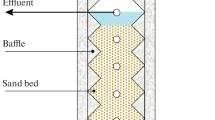Abstract
A 66 dm3 trickle-bed bioreactor was constructed to assess the possibilities of eliminating dichloromethane from industrial waste gases. The trickle-bed bioreactor was filled with a randomly-stacked polypropylene packing material over which a liquid phase was circulated. The pH of the circulating liquid was externally controlled at a value of 7 and the temperature was maintained at 25 °C. The packing material was very quickly covered by a dichloromethane-degrading biofilm which thrived on the dichloromethane supplied via the gas phase. The biological system was very stable and not sensitive to fluctuations in the dichloromethane supply. Removal of dichloromethane from synthetic waste gas was possible down to concentrations well below the maximal allowable concentration of 150mg/m3 required by West-German law for gaseous emissions. At higher dichloromethane concentrations specific dichloromethane degradation rates of 200 g h−1 m−3 were possible. At very low inlet concentrations, dichloromethane elimination was completely mass transfer limited.
The gas-phase mixing could be described by a series of 10 to 7 identical ideally-mixed tanks for superficial gas velocities ranging from 150 to 450 m/h. Dichloromethane elimination with the tricklebed bioreactor was modelled using an overall mass-transfer coefficient that was dependent on the gas and liquid velocities. Masstransfer resistance within the biofilm was also accounted for. Using the model, elimination efficiencies were predicted which were very close to the experimentally observed values.
Similar content being viewed by others
References
Bird, R. B.; Stewart, W. E.; Lightfoot, E. N.: Transport phenomena. New York: John Wiley and Sons 1960
Brink, L. E. S.; Tramper, J.: Modelling the effects of mass transfer of propene epoxidation of immobilized Mycobacterium cells: Pseudo-one-substrate conditions and negligible product inhibition. Enzyme Microb. Technol. 8 (1986) 281–288
Brunner, W. B.; Staub, D.; Leisinger, T.; Bacterial degradation of dichloromethane. Appl. Environ. Microbiol. 40 (1980) 950–958
Etzensperger, M.; Thoma, S.; Petrozzi, S.; Dunn, I. J.: Phenol degradation in a three-phase biofilm fluidized sand bed reactor. Bioproc. Eng. 4 (1989) 175–181
de Gooijer, C. D.; Hens, H. J. H.; Tramper, J.: Optimum design for a series of continuous stirred tank reactors containing immobilized biocatalyst beads obeying intrinsic Michaelis-Menten kinetics. Bioproc. Eng. 4 (1989) 153–158
Gälli, R.; Leisinger, T.: Specialized strains for the removal of dichloromethane from industrial waste. Cons. Recycling 8 (1985) 91–100
Gälli, R.: Biodegradation of dichloromethane in waste water using a fluidized bed bioreactor. Appl. Microbiol. Biotechnol. 27 (1987) 206–213
Gossett, J. M.: Measurement of Henry's law constant for C1 and C2 chlorinated hydrocarbons. Environ. Sci. Technol. (1987) 202–208
Guicherit, R.; Schulting, F. L.: The occurrence of organic chemicals in the atmosphere of the Netherlands. Sci. Total Environ. 43 (1985) 193–219
Harris, N. P.; Hansford, G. S.: A study of substrate removal in a microbial film reactor. Water Res. 10 (1976) 935–943
Hartmans, S.; de Bont, J. A. M.; Tramper, J.; Luyben, K. C. A. M.: Bacterial degradation of vinyl chloride. Biotechnol. Lett. 7 (1985) 383–388
Hoehn, R. C.; Ray, A. D.: Effects of thickness on bacterial film. Journal Water Pollution Control Federation 45 (1973) 2302–2320
Klecka, G. M.: Fate and effects methylene chloride in activated sludge. Appl. Environ. Microbiol. 44 (1982) 701–707
Kohler-Staub, D.; Leisinger, T.: Dichloromethane dehalogenase of Hyphomicrobium sp. strain DM2. J. Bacteriol. 162 (1985) 676–681
Kohler-Staub, D.; Hartmans, S.; Gälli, R.; Suter, F.; Leisinger, T.: Evidence for identical dichloromethane dehalogenases in different methylotrophic bacteria. J Gen. Microbiol. 132 (1986) 2837–2843
Luyben, K. C. A. M.; Tramper, J.: Optimal design for continuous tirred tank reactors in series using Michaelis-Menten kinetics. Biotech. Bioeng 24 (1982) 1217–1220
Lyderson, A. L.: Mass transfer in engineering practice. Chicester: John Wiley and Sons, 1983
Ottengraf, S. P. P.: Exhaust gas purification. In: Schönborn, W. (ed) Biotechnology vol 8, Microbial degradations, pp. 425–452. Weinheim, FRG: Chemie Verlag 1986
Ranz, W. E.; Marshall, W. R.: Evaporation from drops. Chem. Eng. Progr. 48 (1952) 141–146, 173–180
Rittmann, B. E.; McCarty, P. L.: Utilization of dichloromethane by suspended and fixed film bacteria. Appl. Environ. Microbiol. 39 (1980) 1225–1226
Stucki, G.; Gälli, R.; Ebershold, H. R.; Leisinger, T.: Dehalogenation of dichloromethane by cell extracts of Hyphomicrobium DM2. Arch. Microbiol. 130 (1981) 366–371
Scholtz, R.; Wackett, L. P.; Egli, C.; Cook, A. M.; Leisinger, T.: Dichloromethane dehalogenase with improved catalytic activity isolated from a fast-growing dichloromethane-utilizing bacterium. J. Bacteriol. 170 (1988) 5698–5704
Wilke, C. R.; Chang, P.: Correlation of diffusion coefficients in dilute solutions. Am. Inst. Chem. Eng. J. 1 (1955) 264–270
Author information
Authors and Affiliations
Rights and permissions
About this article
Cite this article
Hartmans, S., Tramper, J. Dichloromethane removal from waste gases with a trickle-bed bioreactor. Bioprocess Engineering 6, 83–92 (1991). https://doi.org/10.1007/BF00369060
Received:
Issue Date:
DOI: https://doi.org/10.1007/BF00369060




